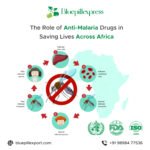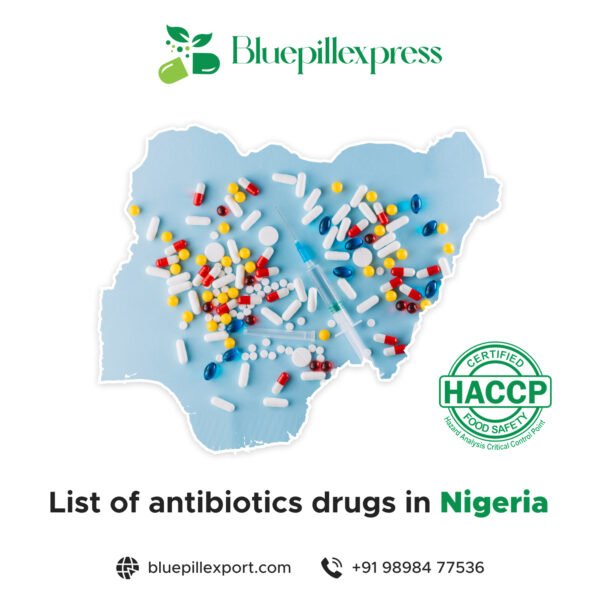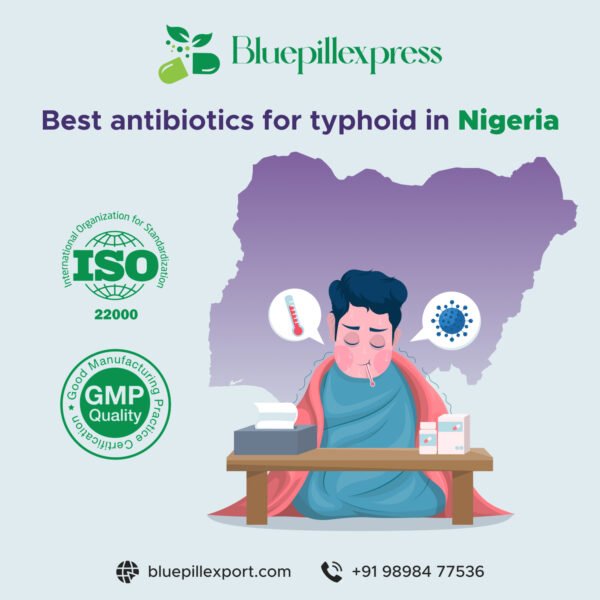The Most Popular Antibiotics in Nigeria (and How to Use Them Responsibly)
Antibiotics remain essential for modern healthcare in Nigeria—saving lives from bacterial infections ranging from pneumonia to sepsis. At the same time, misuse and overuse have accelerated antimicrobial resistance (AMR), making common infections harder (and costlier) to treat. Understanding which antibiotics are most commonly used in Nigeria—and when they’re appropriate—helps hospitals, clinics, pharmacies, and importers make smarter, safer decisions.
This BluepillExpress primer brings together recent Nigerian studies, hospital utilization reports, and national policy guidance to map today’s antibiotic landscape. You’ll find the top molecules by real-world use, their typical clinical roles, key stewardship cautions, and what the latest Nigerian policy says about responsible access.
Quick take: Which antibiotics are most popular in Nigeria?
Across community and hospital settings in Nigeria, the following generics frequently top prescription and consumption lists:
- Amoxicillin (Access group)
- Amoxicillin–clavulanate (co-amoxiclav)
- Metronidazole
- Ciprofloxacin
- Cefuroxime
- Ceftriaxone
- Azithromycin
- Doxycycline
- Cloxacillin / Ampicillin–cloxacillin (Ampiclox)
- Co-trimoxazole (trimethoprim–sulfamethoxazole)
- Gentamicin
- Clarithromycin
Multiple Nigerian studies—spanning tertiary hospitals, outpatient departments, and community surveys—consistently report heavy use of co-amoxiclav, ciprofloxacin, metronidazole, amoxicillin, cefuroxime, and ceftriaxone, with macrolides (azithromycin/clarithromycin), tetracyclines (doxycycline), and aminoglycosides (gentamicin) also common. PMCpharmacy-journal.iuokada.edu.ngAfrican Journals OnlineSciSpaceBioMed Central
Nigeria-specific consumer surveys echo this pattern, especially highlighting amoxicillin, metronidazole, and ciprofloxacin as frequently used in the community. ScienceDirect
Important: Under Nigerian law, antibiotics are prescription-only medicines. Regulators have repeatedly warned against OTC sales and emphasize tighter enforcement to slow AMR. NAFDACPMC
Why these antibiotics are so widely used
Popularity doesn’t always mean “best”; it reflects availability, clinician familiarity, local bacterial epidemiology, and cost. It also reflects historical habits—some good, some risky—especially when “Watch” antibiotics (e.g., ciprofloxacin, azithromycin, ceftriaxone) are used as first-line options when “Access” agents (e.g., amoxicillin) would suffice.
The WHO AWaRe framework classifies antibiotics as Access, Watch, or Reserve to guide safer use. Nigerian point-prevalence surveys show substantial use of Watch antibiotics in hospitals—an AMR concern and a focus for stewardship programs. PMCPubMed
The top antibiotics in Nigeria: indications, pearls & cautions
Disclaimer: Information below is educational and not a substitute for a licensed prescriber’s judgment. Always follow local guidelines and individual patient factors.
Amoxicillin (Access)
Typical roles: First-line for community-acquired respiratory infections (e.g., otitis media, sinusitis), some skin/soft tissue infections, susceptible urinary tract infections (UTIs).
Why popular: Affordable, widely available, broad enough for many first-line needs.
Stewardship tip: Confirm likely bacterial cause; avoid for viral URTIs. Consider allergy history and local resistance patterns. Evidence shows amoxicillin ranks among the most used antibiotics in Nigerian settings. PMCSciSpace
Amoxicillin–Clavulanate (Co-amoxiclav)
Typical roles: When beta-lactamase producers are suspected; bite wounds; polymicrobial infections.
Why popular: Adds beta-lactamase protection, making it effective where plain amoxicillin may fail.
Nigerian use: Frequently reported as the most prescribed inpatient and outpatient antibiotic in multiple Nigerian hospitals. PMCpharmacy-journal.iuokada.edu.ngAfrican Journals Online
Stewardship tip: Reserve for cases where clavulanate’s added spectrum is justified—don’t default to it as a first-line for every cough.
Metronidazole
Typical roles: Anaerobic infections, intra-abdominal sepsis, gynecologic infections, surgical prophylaxis in specific procedures; also for protozoal infections.
Why popular: Excellent anaerobic coverage; low cost.
Nigerian use: Consistently appears in top-five hospital and community consumption lists. PMCBioMed Central
Stewardship tip: Avoid outside anaerobic/protozoal indications; not a general “stomach drug.”
Ciprofloxacin (Fluoroquinolone; Watch)
Typical roles: Complicated UTIs, some gastrointestinal infections, certain resistant gram-negative infections.
Why popular: Potent oral gram-negative coverage with good tissue penetration.
Nigerian use: Frequently among the top two or three prescribed antibiotics; high use flagged in stewardship analyses. PMCLippincott Journals
Stewardship cautions: Tendinopathy, QT risk, collateral resistance selection; avoid as first-line when Access options work.
Cefuroxime (2nd-Gen Cephalosporin; Watch)
Typical roles: Respiratory infections, skin infections, some UTIs (depending on susceptibility).
Nigerian use: Regularly reported in top ten hospital prescriptions; common in outpatient lists. PMCAfrican Journals Online
Stewardship tip: Ensure indication and susceptibilities justify a Watch agent.
Ceftriaxone (3rd-Gen Cephalosporin; Watch)
Typical roles: Severe community-acquired infections (e.g., pneumonia, meningitis), sepsis, typhoid (guided by local sensitivity).
Why popular: Once-daily dosing, broad coverage, parenteral route.
Nigerian/African hospitals: Among the most used inpatient antibiotics continent-wide, including Nigeria. SpringerLinkBioMed Central
Stewardship tip: Strong stewardship oversight needed; step down to oral Access agents once stable and susceptible.
Azithromycin (Macrolide; Watch)
Typical roles: Atypical respiratory pathogens, some STIs, alternative for certain penicillin-allergic patients.
Nigerian use: Present but generally behind beta-lactams and metronidazole; still common in many formularies. PMC
Stewardship tip: Avoid routine pairing with beta-lactams unless clinically indicated.
Doxycycline (Tetracycline; Access in many indications)
Typical roles: Some respiratory infections, acne, certain atypical pathogens, STIs, rickettsial diseases.
Why popular: Versatile, oral, relatively low cost.
Stewardship tip: Photosensitivity; avoid in pregnancy/young children; check local resistance trends.
Cloxacillin / Ampicillin–Cloxacillin (Ampiclox)
Typical roles: Penicillinase-producing staphylococcal skin/soft tissue infections; post-partum mastitis.
Nigerian use: Historically popular in community self-medication studies; still widely known to consumers by brand/generic. IJID
Stewardship tip: Confirm staphylococcal etiology; don’t use for MRSA; avoid indiscriminate use for nonspecific “boils.”
Co-trimoxazole (Trimethoprim–Sulfamethoxazole; Access)
Typical roles: UTIs (variable resistance), Pneumocystis prophylaxis (HIV care), some skin infections.
Why popular: Longstanding availability and affordability.
Stewardship tip: Check susceptibility before using for UTIs due to resistance variability.
Gentamicin (Aminoglycoside)
Typical roles: Serious gram-negative infections; often in combination regimens; neonatal sepsis protocols.
Why popular: Powerful IV option in resource-constrained settings.
Stewardship tip: Requires dosing/monitoring for nephro- and ototoxicity; avoid prolonged courses without levels.
Clarithromycin (Macrolide; Watch)
Typical roles: H. pylori regimens, atypical respiratory pathogens.
Nigerian use: Appears in hospital prescription lists though less than azithromycin in many places. PMC
What Nigerian data says about prescribing patterns
- Hospitals: Point-prevalence and utilization studies from multiple tertiary centres show co-amoxiclav, ciprofloxacin, metronidazole, amoxicillin, cefuroxime, and ceftriaxone dominating prescriptions. Some reports note Watch antibiotics (e.g., ciprofloxacin, ceftriaxone) are used more than desirable under AWaRe best practices, prompting stewardship efforts. PMC+1pharmacy-journal.iuokada.edu.ngAfrican Journals Online
- Community use & self-medication: Nigerian surveys indicate amoxicillin, metronidazole, and ciprofloxacin are commonly self-used without prescriptions—often guided by pharmacists or prior experience. This pattern is a critical driver of AMR and is explicitly discouraged by regulators. ScienceDirectPMC
- Continental context: Meta-analyses across African hospitals likewise list ceftriaxone, metronidazole, ciprofloxacin, ampicillin, and cefuroxime among the most used agents—consistent with Nigerian trends. PMCSpringerLink
Regulation & stewardship in Nigeria: what’s changed?
- Prescription-only status: NAFDAC and PCN classify antibiotics as prescription-only and have called to stop OTC sales, tighten distribution, and improve pharmacovigilance. NAFDAC
- National AMR Action Plans:
- NAP 1.0 (2017–2022): Laid the initial governance and surveillance framework. Nigeria Centre for Disease Control
- NAP 2.0 (2024–2028): Expands stewardship, surveillance, and One-Health coordination across human, animal, and environmental sectors. WHO | Regional Office for AfricaOne Health TrustNigeria Centre for Disease Control
- Enforcement realities: Scholarly analyses note gaps in on-the-ground enforcement due to resource constraints, which makes private-sector discipline and internal compliance programs even more important. PMC
Five practical stewardship guardrails for Nigeria
- Start with Access agents when appropriate.
Amoxicillin or doxycycline (context-dependent) may be preferable to Watch drugs for many uncomplicated community infections—follow national and local guidelines. Nigerian hospital audits show room to shift away from routine Watch use. PMC - De-escalate and shorten courses.
Use culture results to narrow spectrum and step down to oral therapy promptly. Avoid prolonged broad-spectrum coverage. - No OTC antibiotics.
Enforce prescription-only internal policies across your chain. NAFDAC has urged an end to OTC antibiotic sales. NAFDAC - Invest in pharmacist-led AMS.
Nigerian facilities that track utilization and educate prescribers see safer use patterns over time. PMC - Handle expired products correctly.
Follow NAFDAC’s Good Distribution Practice and disposal guidance; many community pharmacists channel expired antibiotics to NAFDAC through their association. NAFDAC
Buyer’s guide for hospitals, clinics & pharmacies (from BluepillExpress)
At BluepillExpress, we work with clients to build resilient, compliant antibiotic portfolios. Here’s a neutral, stewardship-aligned way to think about stocking:
- Core Access backbone:
- Amoxicillin (multiple strengths, pediatric formulations)
- Co-trimoxazole
- Doxycycline
- Cloxacillin (and, where appropriate, ampicillin–cloxacillin)
- Gentamicin (hospital IV)
- Targeted Watch agents (use judiciously):
- Amoxicillin–clavulanate
- Cefuroxime (oral and IV)
- Ceftriaxone (IV)
- Ciprofloxacin (reserve for indicated cases)
- Azithromycin / Clarithromycin (specific indications)
- Formulation diversity:
Include suspensions for pediatrics, IV/IM for inpatient settings, and blister-pack or unit-dose options to minimize wastage. - Quality & compliance:
Source only NAFDAC-registered products with full documentation (CoPP where applicable), batch traceability, and clear cold-chain procedures for temperature-sensitive lines.
We strictly honor prescription-only rules and stewardship principles in our fulfillment protocols, aligning procurement with Nigeria’s AMR action plan objectives. WHO | Regional Office for Africa
Common questions (answered briefly)
Q1: Are antibiotics in Nigeria really overused?
A: Nigerian and WHO-supported surveys show high antibiotic use and frequent non-prescription access—key AMR drivers the government is addressing via NAP 2.0 and stronger pharmacy oversight. WHO | Regional Office for Africa+1
Q2: Which single antibiotic is “number one”?
A: It varies by setting, but co-amoxiclav, amoxicillin, metronidazole, ciprofloxacin, cefuroxime, and ceftriaxone are consistently among the top. Hospital audits often place co-amoxiclav and ciprofloxacin near the top; community surveys frequently highlight amoxicillin and metronidazole. PMCpharmacy-journal.iuokada.edu.ngScienceDirect
Q3: Should I stock more Watch antibiotics because they’re popular?
A: Not necessarily. Popularity isn’t a stewardship plan. Balance your formulary to prioritize Access agents, then add Watch drugs for clearly defined indications and protocols. PMC
Q4: Can pharmacies dispense antibiotics without a prescription?
A: No. NAFDAC states antibiotics are prescription-only; the agency has urged an end to OTC sales. NAFDAC
Putting it all together: a responsible antibiotic portfolio for Nigeria
Clinical need and stewardship should drive selection—not tradition or consumer demand. Based on Nigerian utilization evidence and policy:
- Anchor on Access: Amoxicillin, doxycycline, co-trimoxazole, cloxacillin, and gentamicin (in hospital).
- Use Watch wisely: Co-amoxiclav, cefuroxime, ceftriaxone, ciprofloxacin, and macrolides should be indication-driven and time-limited.
- Follow NAFDAC and NAP 2.0: Enforce Rx-only access; monitor use; educate staff; and dispose of expired stock properly.
How BluepillExpress supports safer access
- Compliance-first sourcing: Only NAFDAC-registered lines and audited manufacturers.
- Documentation at your fingertips: Batch COAs, pack inserts, and stability data on request.
- Stewardship-aware assortments: We help align product selection to local guidelines and AWaRe principles.
- Training support: Briefings for prescribers and pharmacists on responsible use and product handling (upon request).
BluepillExpress partners with hospitals, clinics, and licensed pharmacies to improve access without compromising on stewardship. If you need a curated, policy-aligned list of SKUs (strengths, dosage forms, pack sizes) for your specific facility type, we can draft it to match your formularies and patient mix—while keeping to Nigeria’s regulatory expectations.






 IndiaMart
IndiaMart
 FIEO
FIEO









